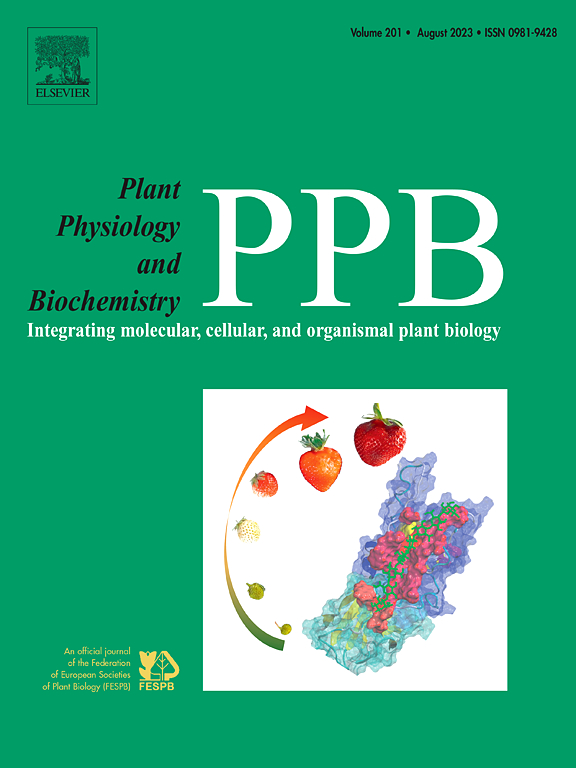对施氮敏感且与产量密切相关的小麦无损检测性状的选择
IF 5.7
2区 生物学
Q1 PLANT SCIENCES
引用次数: 0
摘要
作物生长性状的快速、无损检测可以指导氮素的诊断和管理。然而,对不同氮素投入条件下多种无损测量作物性状的综合研究尚缺乏。本研究旨在探讨36个无损检测的小麦性状对施氮量的响应,并评价哪些性状对施氮量敏感且与小麦产量密切相关。这36个性状包括植株形状性状、生理性状、物理性状和叶色性状。田间试验包括24个处理,即8个施氮量(0、50、100、150、200、250、300和350 kg N ha−1)和3个农田(2、5和8年,分别记为Farmland2yr、Farmland5yr和Farmland8yr)的组合。结果表明,籽粒产量最高的施氮量分别为350.0 kg(农田2yr)、286.7 kg(农田5yr)和217.6 kg N ha−1(农田8yr)。施氮增加了大部分植株形状、生理和物理性状;而它倾向于降低大多数叶色性状。在研究的36个性状中,19个性状对施氮敏感,且与小麦产量密切相关。19个性状分别为株高、茎粗、平均叶长、平均叶宽、平均叶面积、平均叶体积、单茎叶面积、叶面积指数、叶SPAD、叶量子产率、叶氮含量、叶表面水分、叶表面温度、冠层辐射透过率、叶片NBI、RDBI、GDBI、BDBrI和RDLI。这些性状可作为小麦生产中氮素快速诊断系统的参考。该研究结果有望加深我们对多种非破坏性测量植物性状对氮素水平的响应的认识,并为建立快速诊断系统和粮食产量预测模型提供重要信息。本文章由计算机程序翻译,如有差异,请以英文原文为准。
Selection of non-destructively measured wheat traits sensitive to nitrogen application and closely related to wheat yields
Rapid and non-destructive detection of crop growth traits can guide nitrogen (N) diagnosis and management. However, there is a lack of comprehensive studies on multiple non-destructively measured crop traits under different N inputs. The study aimed to investigate the responses of 36 non-destructively measured wheat traits to N application rates, and to assess which traits are sensitive to N application and closely related to wheat yields. The 36 traits included plant shape traits, physiological traits, physical traits, and leaf color traits. Field experiment included 24 treatments, i.e., the combination of eight N application rates (0, 50, 100, 150, 200, 250, 300, and 350 kg N ha−1) and three farmlands (farmland converted from wasteland for 2, 5, and 8 years, denoted as Farmland2yr, Farmland5yr, and Farmland8yr). Results showed that the N application rate for the greatest grain yield was 350.0 (Farmland2yr), 286.7 (Farmland5yr), and 217.6 kg N ha−1 (Farmland8yr). Nitrogen application tended to increase most plant shape, physiological, and physical traits; while it tended to reduce most leaf color traits. Among the 36 traits studied, 19 traits were sensitive to N application and closely related to wheat yields. The 19 traits were plant height, stem diameter, mean leaf length, mean leaf width, mean leaf area, mean leaf volume, single stem leaf area, leaf area index, leaf SPAD, leaf quantum yield, leaf N content, leaf surface moisture, leaf surface temperature, canopy radiation transmittance, leaf NBI, RDBI, GDBI, BDBrI, and RDLI. These traits can be considered for the establishment of rapid N diagnosis systems in wheat production. The findings are expected to deepen our understanding of the responses of multiple non-destructively measured plant traits to N levels, and provide essential information for the establishment of rapid N diagnosis systems and grain yield prediction models.
求助全文
通过发布文献求助,成功后即可免费获取论文全文。
去求助
来源期刊
CiteScore
11.10
自引率
3.10%
发文量
410
审稿时长
33 days
期刊介绍:
Plant Physiology and Biochemistry publishes original theoretical, experimental and technical contributions in the various fields of plant physiology (biochemistry, physiology, structure, genetics, plant-microbe interactions, etc.) at diverse levels of integration (molecular, subcellular, cellular, organ, whole plant, environmental). Opinions expressed in the journal are the sole responsibility of the authors and publication does not imply the editors'' agreement.
Manuscripts describing molecular-genetic and/or gene expression data that are not integrated with biochemical analysis and/or actual measurements of plant physiological processes are not suitable for PPB. Also "Omics" studies (transcriptomics, proteomics, metabolomics, etc.) reporting descriptive analysis without an element of functional validation assays, will not be considered. Similarly, applied agronomic or phytochemical studies that generate no new, fundamental insights in plant physiological and/or biochemical processes are not suitable for publication in PPB.
Plant Physiology and Biochemistry publishes several types of articles: Reviews, Papers and Short Papers. Articles for Reviews are either invited by the editor or proposed by the authors for the editor''s prior agreement. Reviews should not exceed 40 typewritten pages and Short Papers no more than approximately 8 typewritten pages. The fundamental character of Plant Physiology and Biochemistry remains that of a journal for original results.

 求助内容:
求助内容: 应助结果提醒方式:
应助结果提醒方式:


